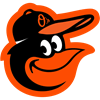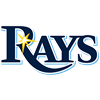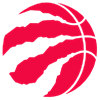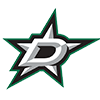After focusing on hitters in the last installment of my series on best-ball drafts with Underdog Fantasy, it's time to turn to pitching. This article will break down the top-50 pitchers by projection into tiers, with comments on specific players and roster construction implication included for each tier. These tiers were constructed strictly off the projections found on RotoWire as an exercise, not necessarily as a cheat sheet for drafts.
I have now completed four drafts on the Underdog platform, and in each I have used either seven or eight of my 18 picks on pitchers. Interestingly, the most common build among the teams in the drafts in which I have participated is to take six pitchers, though seven is also fairly common. Drafting eight pitchers is a relatively extreme strategy, as only nine of the 48 teams sampled selected that many. However, given the lack of any FAAB, short benches and the likelihood of pitchers getting hurt compared to either infielders or outfielders, going with a pitching heavy approach appears to be optimal.
With some of the general ideas out of the way, it's time to jump into the tiered analysis with overall thoughts as well as some specific player analysis. Some thoughts on roster construction will follow.
Tier 1
| Name | Proj. Points | ADP |
|---|---|---|
| Gerrit Cole | 1,440 | 4.0 |
| Shane Bieber | 1,437 | 9.4 |
| Jacob deGrom | 1,426 | 6.6 |
As in traditional 5x5 formats, this trio stands among the rest at starting pitcher. All three will go in the first round and would require passing on an elite outfielder or a difference-making infielder such as Freddie Freeman or Fernando Tatis. That may be worth it from a team-building perspective, as all three of these aces project to give a significant advantage at the position. As will be highlighted in Tier 2, the next closest pitcher projection is for 1,305 points — more than 100 points fewer than deGrom.
Tier 2
| Name | Proj. Points | ADP |
|---|---|---|
| Aaron Nola | 1,305 | 21.9 |
| Trevor Bauer | 1,287 | 12.4 |
| Lucas Giolito | 1,241 | 20.8 |
| Yu Darvish | 1,240 | 19.4 |
There's an argument that Tier 2 should be split into Tier 2 and Tier 3, with Nola and Bauer above Giolito and Darvish. However, due to the relatively tight band of scoring and ADP it's worth expanding from an analysis perspective. Generally, I want to start a draft with at least one pitcher from one of the top two tiers and am not necessarily opposed to starting my drafts with one pitcher from Tier 1 and Tier 2.
Best Value: Nola. Simply, Nola has the lowest ADP and the highest projected points in the tier. Beyond that simple observation, Nola offers a nice blend of stability and upside, as he's had an ERA less than 4.00 in all but one of his six seasons in the league and has also been a workhorse with little exhibited injury risk. Although Nola's strikeout rate isn't likely to match those of his peers in this tier, he's nevertheless built well for the scoring system as he logged seven quality starts in 12 outings last season.
Bust Risk: Bauer. He's the antithesis of Nola as he's posted an ERA higher than 4.00 in five of his seven full seasons in the majors. On the other hand, when Bauer has been good, he's been arguably the best pitcher in the league. He also works deep into games, as he completed five innings in all of his starts and averaged 106 pitches per outing last season. Now on one of the best teams in the league, he'll often line up for both wins and quality starts — a feat rewarded with a combined 10 points. That's all to say Bauer isn't necessarily out of his place at his ADP. However, from a roster construction standpoint, Bauer fails to offer the same advantage in projected points as any of the pitchers in Tier 1 yet is closest to them in cost at this tier. It will likely require a late first-round or very early second-round pick to land him, a spot where I'd prefer to take the likes of Bryce Harper, Freddie Freeman or Jose Ramirez.
Tier 3
| Name | Proj. Points | ADP |
|---|---|---|
| Lance Lynn | 1210 | 46.7 |
| Max Scherzer | 1201 | 16.4 |
| Luis Castillo | 1201 | 25.8 |
| Zac Gallen | 1193 | 55.7 |
This group remains tightly packed in projected points, though ADP starts to spread. This will continue as the draft wears on, but this tier is where projected starts to appear.
Best Value: Lynn. By the projections, this title should belong to Gallen. However, Lynn boasts many of the same durability strengths as Bauer — he threw more than 100 pitches and completed at least 5.0 innings in each of his 13 starts in 2020. He'll also pitch in what is projected to be one of the worst hitting divisions in the league, with his own team the favorite to take the division crown. That should give him the chance to rack up wins and quality starts. Finally, since undergoing Tommy John surgery in 2016, Lynn has never been placed on the injured list.
Bust Risk: Scherzer. Scherzer has the skills to make this look foolish. However, he lost dominance last season in terms of strikeout rate, K-BB% and swinging strike rate. It's possible that was due to the limited number of games, but it's also possible he won't be quite as dominant heading into his age-37 season. With an ADP firmly in the second round, that's a lot of risk to take on with a premium pick.
Tier 4
| Name | Proj. Points | ADP |
|---|---|---|
| Clayton Kershaw | 1127 | 42.6 |
| Brandon Woodruff | 1122 | 47.0 |
This is a reversion to the tighter ADP that was observed in tiers 1 and 2. If drafters opt to follow the projections closely, Kershaw and Woodruff wouldn't stand out as targets as Gallen's ADP is lower, yet projects for more points. Knowing that isn't how drafts play out practically, both Kershaw and Woodruff are solid options.
Kershaw is about as safe as a pitcher can be. Despite having the reputation as being injury prone, he's topped 150 innings in all three seasons prior to the shortened 2020 season. Incredibly, he hasn't had an ERA higher than 3.00 since 2008 — his rookie campaign. The strikeouts aren't gaudy but his ADP is surprisingly low, making him a reasonable target.
Across the last two seasons, Woodruff has posted a combined 23.7 K-BB% and has allowed only 1.0 HR/9. A heavy groundball pitcher, the Brewers boast strong defense — particularly up the middle — thanks to the offseason additions of Kolten Wong and Jackie Bradley Jr.
Tier 5
| Name | Proj. Points | ADP |
|---|---|---|
| Jack Flaherty | 1091 | 31.2 |
| Hyun Jin Ryu | 1079 | 84.2 |
| Zack Greinke | 1071 | 74.0 |
| Tyler Glasnow | 1069 | 43.0 |
| Blake Snell | 1059 | 35.7 |
| Walker Buehler | 1051 | 27.8 |
| Joe Musgrove | 1044 | 106.4 |
| Kyle Hendricks | 1039 | 99.1 |
| Zach Plesac | 1038 | 97.7 |
| Kevin Gausman | 1038 | 115.9 |
| Corbin Burnes | 1033 | 71.3 |
| Jose Berrios | 1027 | 57.7 |
Only 64 projected points differentiate this group of 13 pitchers. Interestingly, the ADP spans much wider, with Buehler being the minimum pick at 27.8 and Gausman the max at 115.9. That makes it relatively easy to spot the values in this tier.
This tier also highlights the importance of volume in the Underdog format, and how it can cover up a deficiency in skills. Diving deeper into the comparison between Buehler and Gausman illustrates this well. Between the duo, Buehler is projected to have a superior K/9 (10.4 vs. 10.0), ERA (2.89 vs. 3.82) and WHIP (0.92 vs. 1.14). Yet, only 13 points separate their points projection as Gausman is projected for one additional start and 14 additional innings. A similar exercise could ensue between Snell/Glasnow and Hendricks.
As discussed with Bauer, this doesn't make Glasnow, Snell or Burnes bad picks. Their ability to rack up strikeouts and excellent skills has league winning upside if they manage to rack up more innings than projected. Instead, the takeaway should be that if drafters invest early round selections in pitching, it's worth skipping the middle rounds to load up on bats because less flashy names will be available later who are still capable of posting the production needed.
Note: Carlos Carrasco was originally included in this tier, but was removed after it was revealed he would miss at least the first month of the season.
Tier 6
| Name | Proj. Points | ADP |
|---|---|---|
| Zach Eflin | 1004 | 150.2 |
| Dylan Bundy | 975 | 115.0 |
| Patrick Corbin | 971 | 73.7 |
| Zack Wheeler | 971 | 88.9 |
| Kenta Maeda | 970 | 61.8 |
| German Marquez | 966 | 95.1 |
| Max Fried | 961 | 82.8 |
| Sandy Alcantara | 961 | 140.1 |
| Marco Gonzales | 958 | 157.4 |
| Aaron Civale | 948 | 146.4 |
| Charlie Morton | 938 | 95.3 |
| Lance McCullers | 937 | 121.2 |
| Andrew Heaney | 937 | 142.6 |
| Sonny Gray | 934 | 58.5 |
| Marcus Stroman | 934 | 134.9 |
| Jesus Luzardo | 931 | 112.2 |
| Chris Bassitt | 928 | 180.9 |
Tier 6 is another tightly packed tier after Eflin, who separates himself by 72 projected points from Bassitt. The ADP spans from 58.5 (Gray) to 180.9 (Bassitt). However, Gray's projected points have taken a hit due to his injury, though his ADP has yet to catch up to that news. At this point in the draft, specific targets will be based on team build. Teams that invest lightly on pitching early in the draft can load up on upside, while teams that started the draft with a Tier 1 pitcher can shoot for the stability of the likes of Stroman.
Nevertheless, a few values stand out as favorites among the tier. Wheeler is one example of a profile that combines stability and upside. He has a relatively clean record of health in recent seasons, as he's spent only 15 days on the injured list since the 2018 campaign. In that three-season span, he's shown the ability to excel in different ways, picking up nearly a strikeout an inning in 2018 and 2019. While his strikeouts ticked down in 2020, he picked up seven quality starts and four wins in 11 outings.
This is the format to invest in Marquez. Bestball allows managers to reap the rewards of his strong skills without suffering through the blowup starts caused by Coors Field.
Tier 7
| Name | Proj. Points | ADP |
|---|---|---|
| Stephen Strasburg | 911 | 67.8 |
| Eduardo Rodriguez | 910 | 128.3 |
| Pablo Lopez | 908 | 136.1 |
| Tyler Mahle | 907 | 151.1 |
| Ian Anderson | 900 | 89.9 |
| Tejay Antone | 897 | N/A |
| Yusei Kikuchi | 885 | 200.0 |
| Mike Minor | 876 | 166.6 |
| Chris Paddack | 875 | 103.7 |
Stability takes a strong turn down beginning in this tier. It's littered with health concerns (Rodriguez and Strasburg), performance concerns (Paddack, Minor, Kikuchi) and likely innings limits (Anderson). However, there a few seemingly stable options, highlighted by Lopez and Mahle. Regardless, these pitchers are most comfortably viewed as depth options, highlighting Strasburg as a particularly risk as by far the highest ADP in the tier.
Strategy Takeaways:
• Target Cole, deGrom or Bieber in the first round. They provide a notable advantage over the rest of the pitching market.
• Drafters who prefer to take a hitter in the first round should do so when they get an early first round pick. In that scenario, Nola, Giolito or Darvish is likely to be available in the second round.
• Draft a pair of pitchers by the end of tier 4. For drafters who prefer to draft hitting early, this could mean drafting Kershaw or Woodruff at their ADP and then hoping Gallen or Lynn is available in the following round.
• There are specific pitching builds available regardless of a drafter's preferred strategy. For drafters whose first-round pick is a pitcher, it will still be worthwhile to draft at least one additional pitcher by the end of Tier 4. However, once ADP and projections loosen from there, projected bargains appear in each tier. For example, Gausman, Musgrove and Hendricks fit this build from Tier 5. From Tier 6, Alcantara, Eflin and Bassitt are available later in the draft, which allows the focus to remain on picking up sufficient hitting to be competitive in the middle rounds.
• For those who draft hitting early, the opposite is a worthwhile strategy. Shoot for the upside in tiers 3 and 4. In Tier 5, Burnes stands out in this construction due to his relatively low ADP (71.0), yet considerable upside that was on display in 2020. In Tier 6, Wheeler, Eflin and Marquez are pitchers who should perform well relative to ADP and allow a drafter to focus on hitting early and gain an advantage with their bats while not giving away too much ground with their pitching.








































